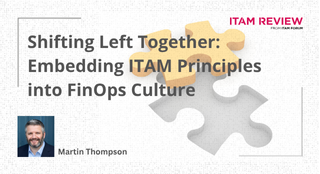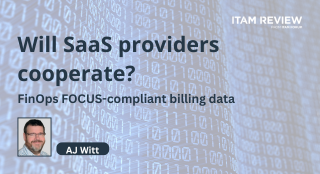AI and ML: The Game Changers in ITAM for 2025
IT Asset Management (ITAM) is experiencing a groundbreaking evolution, heavily influenced by the adoption of Artificial Intelligence (AI) and Machine Learning (ML). These cutting-edge technologies will revolutionise conventional ITAM methods while bringing both exciting possibilities and challenges to organisations around governance.
Here, I explore the skills practitioners must develop, the advantages AI brings, and the crucial areas organisations need to understand to adhere with any regularity and governance requirements.
The Emergence of AI and ML in ITAM
For years, we have heard about AI and ML, but it’s only within the last year or two that we are starting to see this really embraced more broadly. Reports capturing the emergence of AI and ML suggest 77% of organisations have some level of adoption (44% using and 33% experimenting). This is compared to an ~50% adoption rate in 2023, suggesting there has been a significant growth and investment in this space.
Supporting these findings, respondents to a recent “State of Generative AI in the Enterprise” by Deloitte survey advised less than one third of AI experiments have been moved into production. This suggests there is still a sense of trepidation as organisations work out what, how, and who can deliver value leveraging this emerging technology. An interesting statistic coming from this survey is that only 20% of organisations believe they have the talent to promote and execute an AI strategy. This is where we can expect to see significant investment and growth in the next few years as practitioners are enabled by their employers to adopt this new way of working.
Essential Skillsets for ITAM Practitioners
As AI and ML continues to grow, ITAM practitioners must evolve their skillsets to stay relevant and effective. Here are some key areas to focus on:
- Data Literacy: Understanding and interpreting data is fundamental. You should be proficient in data analysis, visualisation tools, and statistical methods to make informed decisions.
- AI and ML Fundamentals: A basic understanding of AI and ML concepts, including algorithm usage and model training, is essential. Familiarity with how to use AI tools and platforms will also be advantageous. We’re starting to see SAM tool vendors introduce AI capabilities to help practitioners ingest business data into their platforms to aid in the predictive cost/spend analysis, contract T&C guidance, and renewal/true-up recommendations, etc.
- Cybersecurity Awareness: With AI systems handling sensitive data, you must be vigilant about cybersecurity threats and best practices to protect asset information from breaches.
- Soft Skills: Critical thinking, problem-solving, and effective communication are vital to effectively collaborate with diverse teams and stakeholders.
The Benefits of AI in ITAM
We are all aware of the potential benefits AI and ML can deliver to the ITAM function, but a recap of these include:
- Automation and Efficiency: Automation of routine tasks such as inventory tracking, software license management, and compliance reporting, freeing up you and your team to focus on strategic initiatives.
- Improved Accuracy: Minimises human errors in asset tracking and reporting, leading to more accurate and reliable data.
- Cost Savings: Optimising asset utilisation and extending asset lifecycles can reduce operational costs.
- Enhanced Decision Making: Actionable insights through data analysis, enabling informed and strategic decision-making.
Concerns and Considerations
Despite its advantages, the introduction of AI in ITAM comes with considerations that organisations must address through clearly defined policies and processes:
- Data Privacy and Security: Ensuring the security of sensitive data processed by AI systems is paramount. Organisations must implement cybersecurity measures and comply with data protection regulations. This includes adopting end-to-end encryption, establishing secure data storage practices, and regularly updating software to protect against vulnerabilities.
- Bias and Fairness: Can the data be trusted? AI algorithms can inadvertently introduce biases present in the training data. Organisations need to regularly audit AI systems to ensure fairness and mitigate bias.
- Regulatory Compliance: As AI technologies evolve, so too will regulatory frameworks. Organisations must stay abreast of regulatory changes and ensure compliance to avoid legal repercussions.
Establishing Effective AI Governance
To leverage the benefits of AI whilst mitigating risks, organisations should implement the following governance strategies:
- Develop a Clear AI Strategy: Define the objectives, scope, and expected outcomes of AI initiatives. Align AI strategies with overall business goals to ensure coherence and relevance.
- Implement Comprehensive Security Measures: Ensure comprehensive cybersecurity protocols to protect AI systems and the data they handle. Regularly conduct security audits and updates.
- Engage in Continuous Learning: Encourage continuous learning and development to stay updated with AI advancements and best practices.
Conclusion
AI and ML are transforming ITAM with increased efficiency and strategic capabilities. To fully benefit, you will need new skillsets, and organisations must establish strong governance frameworks. This will help the ITAM community leverage AI for better asset management and success into 2025 and beyond.
This blog is from Greg Misso, Head of SAM Operations at The Mastermind Group.
Can’t find what you’re looking for?
More from ITAM News & Analysis
-
Broadcom vs Siemens AG - A Brewing Storm
The ongoing legal battle between VMware (under Broadcom ownership) and Siemens is yet another example of why ITAM goes far beyond license compliance and SAM. What might, at first glance, appear to be a licensing dispute, ... -
Shifting Left Together: Embedding ITAM into FinOps Culture
During one of the keynotes at the FinOps X conference in San Diego, JR Storment, Executive Director of the FinOps Foundation, interviewed a senior executive from Salesforce. They discussed the idea of combining the roles of ... -
Addressing the SaaS Data Gap in FinOps FOCUS 2.1
I recently reported on the FinOps Foundation’s inclusion of SaaS and Datacenter in its expanded Cloud+ scope. At that time, I highlighted concerns about getting the myriad SaaS companies to supply FOCUS-compliant billing data. A couple ...
Podcast
ITAM training
Similar Posts
-
Broadcom vs Siemens AG - A Brewing Storm
The ongoing legal battle between VMware (under Broadcom ownership) and Siemens is yet another example of why ITAM goes far beyond license compliance and SAM. What might, at first glance, appear to be a licensing dispute, ... -
Shifting Left Together: Embedding ITAM into FinOps Culture
During one of the keynotes at the FinOps X conference in San Diego, JR Storment, Executive Director of the FinOps Foundation, interviewed a senior executive from Salesforce. They discussed the idea of combining the roles of ... -
Addressing the SaaS Data Gap in FinOps FOCUS 2.1
I recently reported on the FinOps Foundation’s inclusion of SaaS and Datacenter in its expanded Cloud+ scope. At that time, I highlighted concerns about getting the myriad SaaS companies to supply FOCUS-compliant billing data. A couple ... -
The Future of ITAM
As an ITAM Industry Analyst, I’m often asked what ITAM’s future looks like. This can be a tough question to answer because when it comes to the future, there are endless possibilities. Often, it seems, some ...




